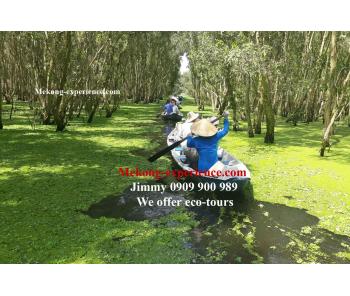DONG THAP PROVINCE IN MEKONG DELTA
{readmore}
(Mekong Ecotour - Mekongeco - Mekong Tour - Good Tours in Mekong - Floating Market in Mekong - Mekong River - Homestay in Mekong - Mekong life - Mekong tourist - Mekong Fishing){readmore}
The fate of 70 million people rests on what happens to the Mekong river. With world leaders meeting in Paris next week for crucial UN climate talks, John Vidal journeys down south-east Asia’s vast waterway - a place that encapsulates some of the dilemmas they must solve. He meets people struggling to deal with the impacts of climate change as well as the ecological havoc created by giant dams, deforestation, coastal erosion and fast-growing cities
John Vidal’s first stop along the river is the tiny country of Laos. Fifty years ago, Laos began to build a series of giant dams. It was the first chance the country had to generate the electricity and money needed to emerge from deep poverty. But is this demand for clean energy creating ecological and human havoc? (Mekong Ecotour - Mekongeco - Mekong Tour - Good Tours in Mekong - Floating Market in Mekong - Mekong River - Homestay in Mekong - Mekong life - Mekong tourist - Mekong Fishing)
Khamlouvilaivong Vanthong’s first job as a civil engineer was on the Nam Ngum dam. It was 1968 and as he helped cut down the dense jungles to build the vast concrete structure on a tributary of the Mekong river in Laos, he would see US B-52 bombers heading east to drop napalm, agent orange and cluster bombs on neighbouring Vietnam, Cambodia and Laos itself.More than two million tonnes of bombs – “one tonne for every Lao citizen”, says Vanthong – fell on the impoverished, mountainous country between 1964 and 1973. But his priority was the dam and not the “American war”, as he called it.
With $28m (£18m) aid from the western powers, he and his colleagues blasted 500,000 tonnes of rock, moved 100,000 cubic metres of soil, poured 350,000 cubic metres of concrete and drowned nearly 25 sq km (10 sq miles) of tropical forest.
Vanthong loved his dam so much he never left. “We designed it to last for 1,000 years and we have achieved more than we ever thought we could. It has helped our country grow faster than we ever anticipated. Hydropower was the dream of the future then and now.”
(Mekong Ecotour - Mekongeco - Mekong Tour - Good Tours in Mekong - Floating Market in Mekong - Mekong River - Homestay in Mekong - Mekong life - Mekong tourist - Mekong Fishing)
Laos is still poor and its disastrous war with the US is barely remembered in Asia’s youngest country where 19 is the median age. Nevertheless, he understands well that the greatest threat said to be facing the country is climate change – courtesy of the emissions of the same countries whose aid money paid for the Nam Ngum dam in 1968. Instead of high explosives and chemicals raining on Lao forests as they did then, now the country must grapple with carbon dioxide emissions from the US, Britain and other industrialised countries, he said. “Nam Ngum is now more important than ever,” said dam builder Vanthong. “We want to build dams and become the world capital of clean energy – a giant battery for the whole Mekong region.”
Thank you very much for reading it, Mekong Cruises & Ecotours
(Mekong Ecotour - Mekongeco - Mekong Tour - Good Tours in Mekong - Floating Market in Mekong - Biking Tour - Mekong life - Mekong Cruise - Good Cruise in Mekong - Mekong Eyes Cruise - Bassac Cruise in Mekong, Bassac, Song Xanh Cruise )




